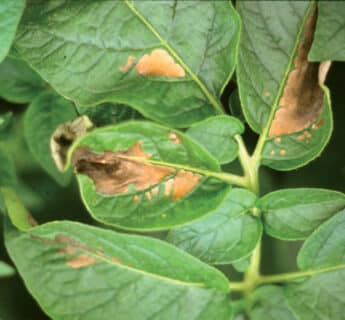Potato plants can be injured when exposed to high concentrations of various air pollutants. Injury can range from visible markings on the foliage to the death of the plant. Growth and yield can also be reduced. The development and severity of injury depends mainly on the concentration of the pollutants in the atmosphere. Crop injury can occur over large areas.
The following environmental conditions are conducive to a build-up of injurious levels of pollutants.
- Atmospheric ozone levels over 80 parts per billion (ppb) for four or five consecutive hours, or 70 ppb for a day or two are usually sufficient to injure exposed foliage at a susceptible stage of growth.
- High levels of automobile exhausts. Crop injury is often visible in fields located close to heavily travelled highways, especially after long weekends.
- Cloudy, hazy overcast days with high humidity and little wind lead to a high concentration of pollutants at ground level and in low spots in fields
- Foggy conditions and heavy dews often contribute to an increase in concentration of air pollutants.
Potato leaves that have been hit by acid rain. Photo: Eugenia Banks
The most important air pollutants in Ontario are:
- Ozone (O3)
- Peroxyacetyl nitrate (PAN)
- Sulfur dioxide (SO2)
Ozone Injury — Ozone is the major component of oxidants in Ontario. It’s formed by the action of sunlight on products of fuel combustion and is moved by wind from roads to nearby fields. Symptoms vary depending on the concentration of ozone in the air and the length of exposure. They range from pepper spotting to flecking. Injury occurs on the most recently emerged leaves. Varietal susceptibility to ozone is another key factor. Yukon Gold, Atlantic and Shepody are very susceptible.
PAN Injury — PAN, like ozone, is produced when sunlight reacts with the gasses in vehicle exhaust. PAN causes tissue collapse on the lower surface of leaves of many plant species. On potatoes, blotches form with a distinctive bronzing, glazing, or silvering. PAN is the most toxic to young leaves.
Sulfur dioxide — Coal burning power plants, smelters and internal-combustion engines produce sulfur dioxide. Exposure to high levels of sulphur dioxide will result in light tan to white necrotic areas in leaves. Yield may be reduced. Losses in sensitive cultivars may be severe following exposure early in the season.
Acid rain — Sulfuric and nitric acid can fall from the atmosphere as rain, snow, fog, hail or even dust. Acidic compounds cause interveinal necrotic spots on upper surface of leaves, yellowing of lower leaves, upward leaf rolling, early maturity, and yield reduction due to early maturity.
What can growers do to help potato plants recover from air pollution and acid rain injuries? If the crop isn’t stressed due to nutrient deficiencies, many growers spray Epsom salts (magnesium sulfate) which greatly help potato plants to recover from oxidants and acidic pollutants.
Header photo — Potato leaves that have been damaged by air pollution. Photo: Eugenia Banks
Related Articles
Bringing Down Nitrous Oxide Emissions on the Farm
Exterminating Verticillium wilt from Potato Fields with Mustard Biofumigation









